
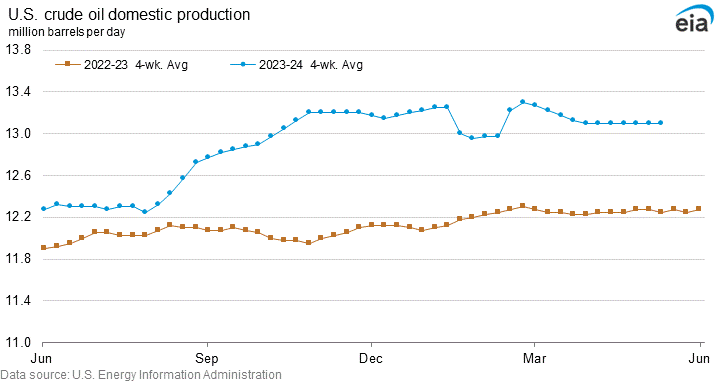
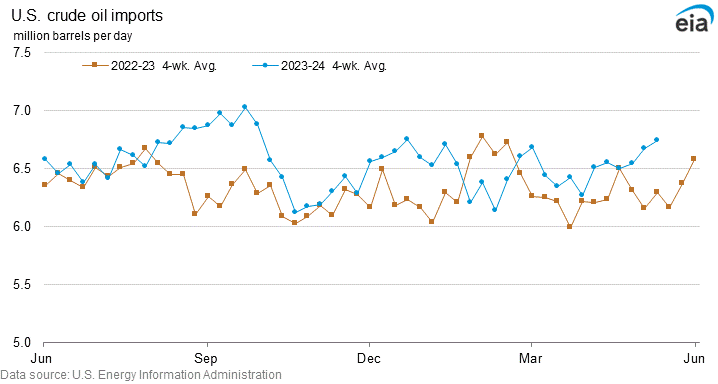
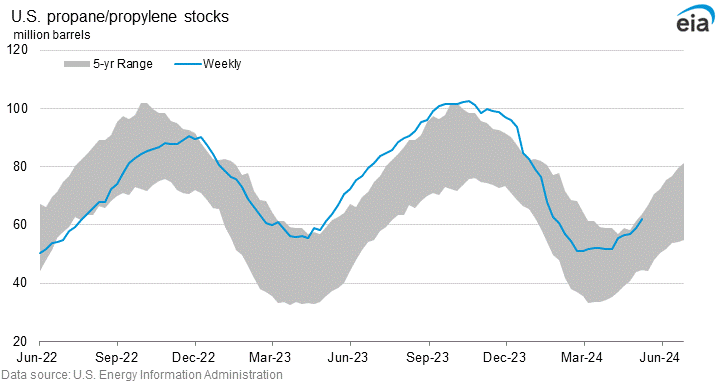
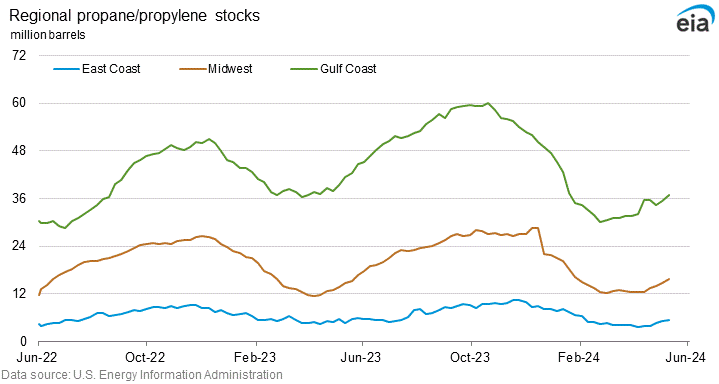
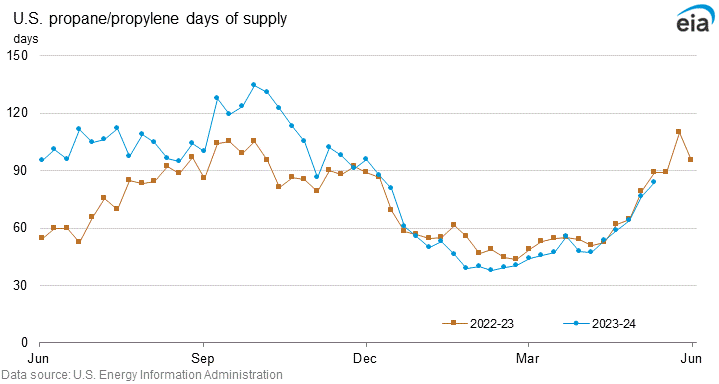
Posted on 10/09/2014 5:44:19 AM PDT by thackney
Heating oil and propane expenditures projected to be lower than last winter
Autumn arrived in the Midwest and the Mid-Atlantic states last week as temperatures turned noticeably colder and snow fell across Wisconsin and Minnesota.
Notwithstanding triple-digit temperatures in parts of California, the winter heating season has begun for much of the country, including the Midwest and the Northeast, where heating oil and propane are important heating fuels. Each October, EIA publishes an outlook for winter energy supply, demand, and prices as part of its October Short-Term Energy and Winter Outlook (STEO). EIA projects the retail price of heating oil to average $3.63 per gallon (gal) this winter heating season (October 2014–March 2015), which would be $0.25/gal lower than the average price during the winter of 2013–14 (Figure 1). This lower heating oil price reflects EIA's forecast for a lower Brent crude oil price. EIA projects the retail propane price during the winter heating season in the Midwest and Northeast to average $0.62/gal and $0.18/gal lower, respectively, than the winter 2013–14 average.
The market for heating fuels is highly dependent on winter temperatures. East of the Rocky Mountains, where propane and oil use as heating fuels is concentrated, the latest forecast by the National Oceanic and Atmospheric Administration (NOAA) projects the upcoming winter to be warmer than the previous one. The Midwest is forecast to be 16% warmer, the South 12% warmer, and the Northeast 11% warmer. The warmer winter weather forecast reflects a return to more historically normal temperatures after the severe cold of last winter.
However, as last winter demonstrated, weather can be very unpredictable, and deviations from expectations can significantly affect demand and prices for heating fuels.
HEATING OIL
As a result of lower projected retail prices and lower expected consumption, EIA expects households heating primarily with heating oil to spend an average of $362 (15%) less this winter than last winter. However, weather and oil price volatility, the adequacy of inventories, and changes in fuel specifications to reduce sulfur content all contribute to uncertainty about this winter’s heating oil market. If temperatures are 10% colder than forecast on a heating-degree-day basis, EIA projects average expenditures will be $124 lower and prices will be $0.16/gal lower than last winter.
Reliance on heating oil is highest in the Northeast (PADDs 1A and 1B), where about 23% of households depend on heating oil for space heating. Nationwide, only 5% of households use heating oil. In the Northeast, distillate inventories (which include heating oil as well as diesel fuel) were 29.3 million barrels on September 26, 15.9 million barrels below the five-year average, but similar to levels last year during that week. In general, the global supply-demand balance for distillate fuels has created a price structure in the futures market that does not encourage building inventory even in advance of the increased demand in the winter months. Although relatively low inventory levels can contribute to price volatility, the Northeast is located in the actively traded Atlantic Basin market from which distillate fuel can be imported during periods of high demand. Last winter, when demand increased as result of colder-than-normal temperatures, PADD 1 distillate fuel imports averaged 294,000 barrels per day (bbl/d) from January through March, up from an average of 133,000 bbl/d during the three previous months. However, if severe weather in the Northeast coincides with severe weather in Europe, supplies in the Atlantic Basin could tighten significantly.
Five states in the Northeast will have more stringent heating oil specifications this winter. Connecticut, Massachusetts, New Jersey, Rhode Island and Vermont lowered the maximum sulfur specification for heating oil on July 1, from 2,000 parts per million (ppm) (and higher) to 500 ppm. No major market impact is expected, as suppliers will either blend higher-sulfur distillate, such as 2,000 ppm heating oil, with 15 ppm ultra-low sulfur diesel (ULSD) or deliver ULSD, whichever is more economic. ULSD is widely available.
New regulations that limit marine fuel sulfur levels in certain coastal waters to 1,000 ppm beginning in January 2015 will also add uncertainty to the heating oil market. To comply with the new regulations, some marine vessels are expected to switch from using higher-sulfur residual fuel oil to lower-sulfur distillate. However, the impact to the Northeast heating oil market is expected to be limited as marine fuel demand in this region is relatively small.
PROPANE
The highest share of households that use propane as a primary winter heating fuel is in the Midwest. Propane use for space heating is also significant in the Northeast. EIA expects households heating primarily with propane to spend less this winter, but the projected decrease varies across regions. EIA expects that households heating with propane in the Midwest will spend an average of $767 (34%) less this winter than last winter, reflecting prices that are about 24% lower and consumption that is 13%. Households in the Northeast are expected to spend an average of $340 (13%) less this winter, with average prices that are about 5% lower and consumption that is 9% lower than last winter. Last year, a particularly large and wet corn crop in the fall increased demand for propane used in crop drying, reducing inventories in the Midwest. Severely cold temperatures followed the corn harvest and also contributed to high propane prices in the Midwest. As of September 26, propane inventories in the Midwest were 28.0 million barrels, slightly above the five-year average and 3.7 million barrels higher than at the same time last year.
Despite higher inventories, the outlook for propane is uncertain. The amount of propane used to process the record corn crop expected this fall will depend on both the weather and commodity prices. Following the harvest, winter temperature outcomes will directly drive the amount of propane used for space heating. Changes in propane supply infrastructure since last winter are another source of uncertainty. The Cochin Pipeline, which previously delivered propane from Canada into the Midwest, was reversed in early 2014. While this reversal will limit the ability to deliver propane into the region, higher propane production from gas plants in the Midwest and new and expanded rail terminals should help to supply propane to the region this winter.
GASOLINE AND DIESEL FUEL PRICES DECLINE
The average U.S. price for a gallon of regular gasoline as of October 6, 2014 was $3.30 per gallon, down six cents from the previous week, and seven cents lower than the same time last year. Prices in all regions declined, led by a 10-cent decrease in the Midwest price to $3.20 per gallon. The Rocky Mountain and Gulf Coast regions followed, down six and five cents respectively, to $3.43 per gallon and $3.11 per gallon. The West Coast price was down four cents to $3.61 per gallon, while the East Coast was down three cents to $3.31 per gallon.
U.S. diesel fuel prices decreased two cents this week to $3.73 per gallon, down sixteen cents from the same time last year. The largest price declines occurred in the East Coast, Midwest, and Gulf Coast regions, each decreasing by more than two cents, to $3.76 per gallon, $3.67 per gallon, and $3.66 per gallon, respectively. The Rocky Mountain and West Coast prices declined by almost two cents, to $3.79 per gallon and $3.93 per gallon, respectively.
PROPANE INVENTORIES RISE
U.S. propane stocks increased by 1.1 million barrels last week to 80.6 million barrels as of October 3, 2014, 14.2 million barrels (21.3%) higher than a year ago. Gulf Coast inventories increased by 0.8 million barrels and Rocky Mountain/West Coast inventories increased by 0.2 million barrels. East Coast inventories increased by 0.1 million barrels while Midwest inventories remained unchanged. Propylene non-fuel-use inventories represented 3.3% of total propane inventories.






And What is more American than Propane?


Looking at the data, it would appear that “expenditures” may be projected to be lower, but people in the biz expect volume to be higher.
More info of that at:
Projected Winter Fuel Expenditures by Fuel and Region
http://www.freerepublic.com/focus/f-news/3212316/posts
It includes volume estimates based upon weather predictions.
What I do not understand is why it is still a premium to unleaded gasoline. Gasoline and diesel have $.40-.60/gallon highway tax. Heating oil does not. For 20 years, heating oil was always about $1.00/gallon less than unleaded gasoline. The last 5 years it has been a premium. What changed?
EPA. The Ultra-low Sulfur Diesel requirements for highway diesel have moved to non-road diesel/fuel oils. It is coming for gasoline in the near future.
When I lived in New England, it seemed that heating oil was cheaper than gasoline. I can see if the new EPA regs require reduction in sulfur how that might change.
But there was another reason the cost of heating oil was lessened: Congress passed a law each year to give a reduction in heating oil costs. this was designed to favor the liberal northeast.
Since you seem to be able to manipulate google pretty good, can you find out what is its status? Are we still subsidizing Yankees?
Glad to hear that. My propane bill last winter was ridiculous.
The only thing close to that I am aware of was the creation of the NE Heating Fuel Reserve to make sure the area had adequate supply when pipeline or weather created supply disruptions.
It was never used until 2012 Hurricane Sandy.
http://energy.gov/fe/services/petroleum-reserves/heating-oil-reserve
There are some low income heating subsidies, but that doesn't help lower the general price of fuel. It only helps pay the actual cost for a select group of people. If anything, it raises them by keeping the demand up for costly fuel oil.
Don’t wait until winter to fill up. Don’t wait until the first frost either.
Sound advice.
http://www.increa.com/homeheat/
This fellow’s prices are somewhat outdated, but with the price of corn (~ $3 per bushel) less than half of what it was last year, corn for heating looks like a good option again.
Disclaimer: Opinions posted on Free Republic are those of the individual posters and do not necessarily represent the opinion of Free Republic or its management. All materials posted herein are protected by copyright law and the exemption for fair use of copyrighted works.